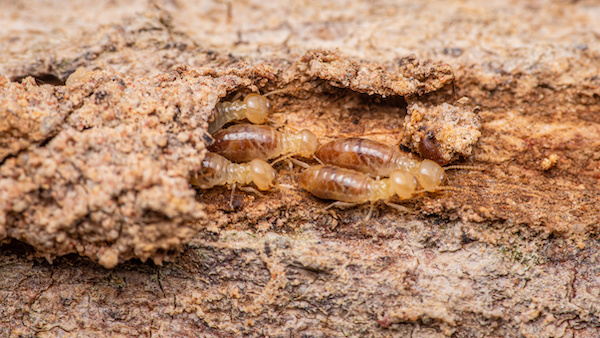As winter sets in, homeowners often assume they’ll have a break from the usual pest battles, believing that the cold weather naturally deters invaders. The frost crunching underfoot and biting winds seem like a temporary shield.
Yet, an unseen threat may persist despite the chill– termites. The question lingers: are termites active in winter?
Join us as we uncover the simple yet crucial details of termite survival, giving you the knowledge to protect your Middletown home from potential winter termite risks!
Termite Biology in Winter
Unlike many insects that enter a state of dormancy during winter, termites employ unique survival strategies to endure the colder months. While their activity does slow down, it doesn’t come to a complete halt.
As winter sets in, some termite species retreat deeper into the ground, seeking refuge from the harsh temperatures at the surface. While many drywood termite species inhabit the wood they destroy in your home, subterranean termites must find warmer retreated underground to sustain the freezing temperatures.
During winter, these termites construct intricate tunnel systems primarily designed to facilitate foraging and adjust to their environment. These tunnels play a multifaceted role, offering a secure pathway for foraging, establishing a stable temperature, and ensuring optimal humidity levels.
Subterranean termites strategically craft these tunnels near homes or heated basements to capitalize on the warmth emanating from nearby food sources.
So, Are Termites Active in Winter?
Termites’ ability to remain active in winter is not uniform across different conditions. The severity of winter plays a significant role in shaping their behavior and activity levels.
Milder Winters: In milder winter conditions, termites may continue foraging for food and expanding their colonies. The relatively moderate temperatures allow them to sustain a higher activity level than harsher winter environments.
Harsh Winter Conditions: In contrast, during harsh winter conditions, termites experience a more pronounced decrease in activity. The extreme cold poses challenges to their survival, leading to a significant slowdown in foraging and colony expansion. This adaptive response helps termites conserve energy and resources during the toughest winter periods.
Effect of Winter on Different Termite Colonies
Termites are active during the winter, but the extent of the impact varies depending on their maturity and establishment.
Established Colonies: For well-established colonies, the colder temperatures may lead to a temporary slowdown in their expansion. These colonies have developed resilient mechanisms to endure winter, but the overall pace of their activities might be affected.
Young Colonies: Young termite colonies, in contrast, face significant challenges during the winter months. The growth of these colonies could be stunted as they navigate the harsh conditions. Winter survival is critical in determining the future trajectory of young termite colonies.
Protecting Your Home
Now that we’ve established that termites are active in winter let’s explore measures to protect your home from potential infestations during this season.
- Regular Inspections: Conduct regular inspections of your property, especially during winter. Look for signs of termite activity, like mud tubes, damaged wood, or discarded termite wings. Early detection can prevent extensive damage.
- Moisture Control: Termites flourish in damp environments. Maintain effective moisture control in and around your home by promptly fixing leaks and ensuring proper drainage.
- Seal Entry Points: Seal any cracks or openings in your home’s foundation and walls. Termites can exploit even the tiniest entry points, so a proactive approach to sealing these gaps is crucial.
Winter Food Sources for Termites:
You may wonder what sustains termite colonies during winter when many outdoor food sources dwindle. Termites are resourceful creatures who can adapt their foraging strategies to survive during the colder months.
- Wood Sources: Termites primarily feed on wood, and during winter, they may target dead trees, fallen branches, or decaying logs. Being extra vigilant is essential if your property has these potential food sources.
- Structural Wood: The warmth of heated homes can attract termites to structural wood within the house. They might exploit wooden elements like beams, furniture, or indoor firewood.
- Mulch and Vegetation: Gardens and mulched areas around homes can provide termites with a consistent food source. Mulch retains moisture, creating favorable conditions for termites. Keep these areas away from your home’s foundation to minimize the risk.
Dispelling Common Misconceptions:
Misinformation can lead to misconceptions about termite behavior, especially during winter. Let’s debunk some common myths and provide accurate information to help homeowners make informed decisions.
Myth: Termites Hibernate in Winter.
Contrary to popular belief, termites do not hibernate during winter. While their activity may decrease, they remain active, albeit at a slower pace. Hibernation is not a part of the termite life cycle.
Myth: Termites Cannot Survive Cold Temperatures.
Termites are resilient insects that can survive in various conditions. While extreme cold might slow their activity, it doesn’t necessarily eliminate them. Termites have adapted mechanisms to endure harsh environments.
Myth: Snow and Ice Protect Homes from Termites.
Some homeowners believe that snow and ice create a protective barrier against termites. However, termites can navigate through these elements to access potential food sources within homes.
Here’s the truth on how to protect your home from termites during the winter:
- Schedule a professional termite inspection before winter sets in. Experienced pest control experts can identify vulnerabilities and suggest preventive measures tailored to your property.
- When constructing or renovating your home, consider using termite-resistant materials. This can be a long-term preventive measure, reducing the risk of termite infestations.
- Maintain a consistent indoor temperature. While it won’t deter termites entirely, it can discourage them from actively foraging indoors.
- Eliminate potential food sources around your property by removing decaying wood, fallen trees, and dead vegetation. Regular yard maintenance can go a long way in minimizing termite attractants.
Dealing with Winter Termite Infestations In New York
In the challenging winter conditions of Orange and Rockland Counties, residents must stay vigilant against termite activity to safeguard their homes. At United States Pest Service, we understand the unique pest challenges that harsh New York winters can bring.
If you suspect termite activity or have identified signs of infestation, please contact us promptly. Our professional pest control services are tailored to these specific regions, and our experts have the knowledge and tools to assess the extent of any infestation and implement effective treatment strategies.
Our commitment doesn’t end there once we’ve addressed the immediate termite issue. We encourage residents to continue monitoring their properties for any signs of termite activity. Our preventive measures are designed to create a protective barrier, minimizing the risk of future infestations.
With United States Pest Service, you’re not just getting a solution to the current problem – you’re partnering with a dedicated team to keep your home termite-free, especially during the winter months in Orange and Rockland Counties.

